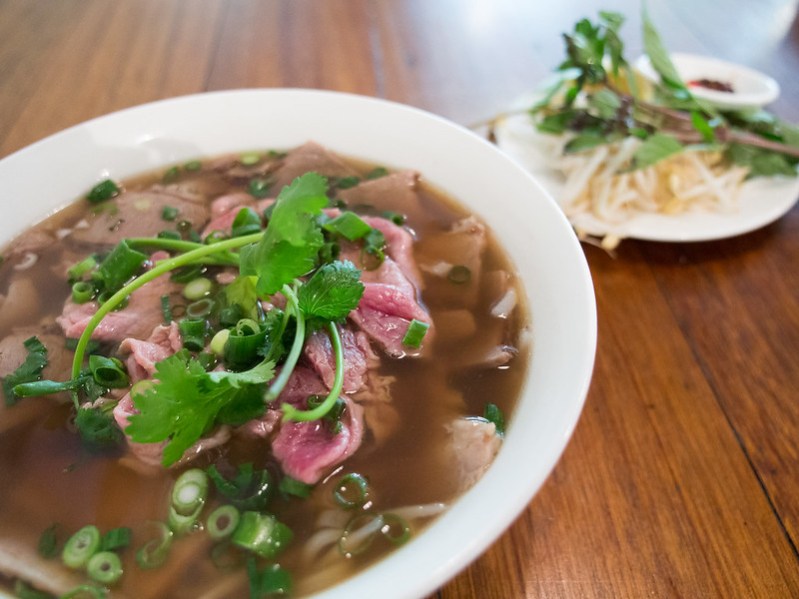
A steaming bowl of rich beef broth brimming with noodles and fragrant herbs, pho is widely considered the most famous dish of Vietnam. Thanks to a widespread Vietnamese diaspora, pho has become international, enjoyed by diners everywhere from California to Germany. You can enjoy pho any time of the year.

Beef pho
(Recipe by Chef Greg Gugunin, formerly of Pho 66 in New York City)
Ingredients:
For the broth
- 10 pounds beef bones (knuckle, marrow bones)
- 2 onions, halved and charred
- 2 oz ginger, sliced
- 1 lemongrass stalk, smashed
- 1 or 2 dried chile de árbol
- 2 cinnamon sticks
- 1-3 pieces of star anise, 1-3 pieces
- 5-10 pieces of clove
- 1-3 pieces Chinese black cardamom
- Banh pho noodles (adjust for number of diners)
For the seasoning (adjust amount to taste)
- Palm sugar
- Fish sauce
- Soy sauce
- Salt
For the meat
- 1-2 pounds of brisket or short ribs
- Salt and pepper (to taste)
- Pho broth
Method:
- Roast bones in a deep pan at 350 degrees Fahrenheit for 15-30 minutes until brown, turning occasionally. Set aside.
- Char onion on grill or stovetop. Use tongs or spatula to remove safely.
- Slice and smash ginger and lemongrass, respectively.
- Place roasted bones, charred aromatics, and dried spices into a large pot. Barely cover the top with water.
- Bring the pot to a simmer for 8-10 hours. Season as you go (palm sugar, salt, fish, and soy sauce. Be careful not to add too much fish sauce).
- Once the broth is finished, carefully strain the broth through a cheesecloth into another large pot. Let it cool, and remove fat (save the fat for seasoning if desired).
- Season the brisket or short ribs with salt and pepper
- Brown meat on all sides in a large pot
- Add finished pho broth to the meat (do not cover meat fully with liquid, about halfway) and braise for 3 hours at a low simmer.
- Chill and coarsely shred and slice the meat.
- Boil banh pho noodles according to the package in plain boiling water.
- Top each bowl with noodles, meat, and scallions before adding hot broth. Serve with bean sprouts, Thai basil, cilantro, lime wedges, shallots, and thinly sliced chile peppers (jalapeno, holland, or serrano).
- Optional variations: Serve with raw, thinly sliced eye of round (1 ounce per bowl), Vietnamese beef meatballs, skirt steak, or short ribs (2 ounces per bowl), grilled and sliced thin.

The history of pho
Surprisingly, pho is traditionally served for breakfast in Vietnam (although the noodles are now consumed at all hours). Pho is often believed to be partially inspired by the French dish, pot de feu. Vietnam was colonized by France in the late 19th century and the culinary influences of that era still reside today, evidenced by Vietnam’s vibrant coffee culture and Vietnamese-style baguettes.
The first pho came from the Nam Dinh and Hanoi regions of North Vietnam. This northern version, known as pho bac, is simple — beef broth accompanied by noodles and thin slices of beef. Southern pho, called pho nam, is more elaborate and seasoned with additional spices and herb garnishes. In America, Southern pho is the most popular version since most Vietnamese Americans immigrated from South Vietnam after the Vietnam War.

The parts of pho
There are several elements to Vietnamese pho. This soup includes broth, noodles, meat, and condiments. Without all these pieces, you wouldn’t have the beloved pho.
Broth
The most important (and time-consuming) aspect of a good bowl of pho is the broth. It takes hours to simmer bones and beef into rich yet clean soup. For the best results, combine marrow (from the leg) or knuckle bones along with brisket or chuck. Oxtails are another great addition because of the combination of meat, fat, and collagen.
It also helps to wash and parboil the bones before cooking, This will remove impurities that rises during the boiling process, which ensures a cleaner broth. While skimming the broth, be careful not to remove the fat, as this surface layer adds beefiness to the finished soup.
Don’t forget to roast your aromatics, as it adds another level of flavor. Also, wrap your spices in a cheesecloth before placing them in the simmering broth to ensure easy removal.
Noodles
The most common type of pho noodles are called banh pho and they’re about the width and shape of linguine or fettuccine. These noodles cook fast and should be prepared separately in plain boiling water before they’re placed in each bowl. Do not overcook the noodles, as hot broth is ladled into each bowl after the ingredients are assembled.
Meat
If your pho broth was made with the addition of brisket or oxtail, simply remove and slice the cooked meat into each bowl before serving. Another option is thinly sliced beef eye of round, placed raw atop the noodles and cooked with the hot broth. For a more luxurious cut, use thinly sliced filet mignon or ribeye. Some pho preparations even include a stir fry of beef, onions, and scallions placed directly into the bowl, giving the soup a savory saltiness.
Finally, don’t be afraid of offal. Beef tendon, when cooked properly, has an unrivaled beefy flavor. Tendons can be purchased in any Asian market, then simply add them to your broth when cooking.
Condiments
One of the best parts about pho is the customization. Eat at any pho restaurant and it’s almost guaranteed that your order of pho will be accompanied by a plate of bean sprouts, basil, chilies, and lime wedges. Add any of these herbs and vegetables to your personal tastes.
Among pho connoisseurs, there’s a key controversy — the addition of sriracha and hoisin sauce. Some pho eaters douse their bowls with the colorful sauces, while others recoil in horror. Interestingly, the sriracha popular in America was created by a Vietnamese immigrant in California. Sriracha in Asia is originally a Thai sauce and much sweeter than the sriracha familiar to Americans. So, if you’re looking for that distinctive red sauce, be sure to buy the Vietnamese American version of sriracha — Huy Fong Foods.

Can you make pho soup vegetarian?
Absolutely! Vegetarian pho, also known as “pho chay,” is a delicious and healthy alternative to the traditional meat-based version. It’s packed with flavor and nutrients, making it a great choice for vegetarians, vegans, or anyone looking for a lighter meal. Here’s how to make it.
Broth
Use a high-quality vegetable broth as the base. You can make your own or use store-bought, opting for low-sodium options. Add aromatic spices like star anise, cinnamon sticks, cloves, ginger, and lemongrass to create a complex flavor profile. Use dried shiitake mushrooms to give it umami depth and richness. The best veggies to include are carrots, onions, and daikon radishes. Simmer them in the broth for additional flavor and nutrients.
Protein
Firm or extra-firm tofu is a great vegetarian protein option. Marinate it in your favorite spices before pan-frying or grilling. You can also use tempeh, marinated and pan-fried, to add a chewy, meaty texture to the pho. Lastly. Adding cooked lentils provides protein and fiber, making the pho soup more filling.



